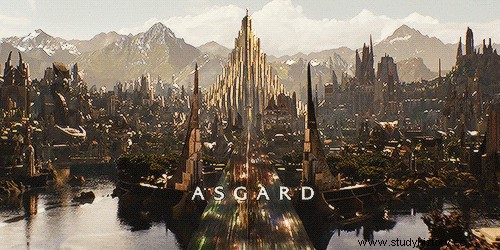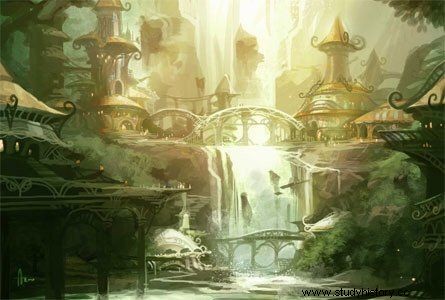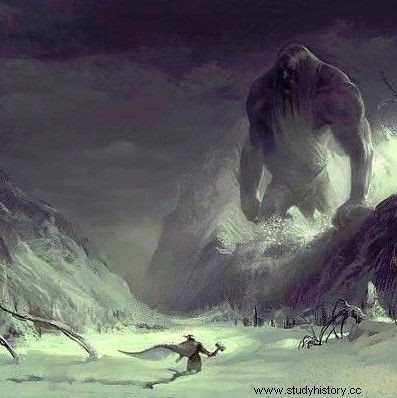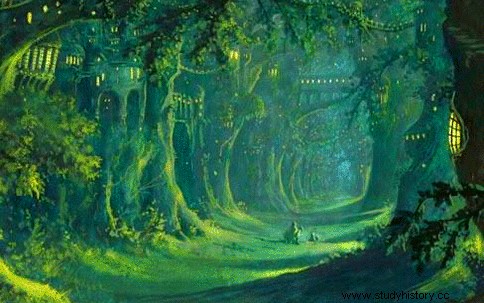In pre-Christian Scandinavia, Nordic mythology refers to the religion, beliefs and stories of the people who settled in Iceland, where the majority of written sources for Norse mythology originated. The Norse gods are mythological characters from the traditions of the North Germanic tribes from the 9th century. Poems were used to convey these stories to the Eddas and other medieval literature was created, which was in the 11th and 18th centuries. Although some of the poems in the poetic Edda convey whole narratives, the majority of them assume that the audience was familiar with the mythical backdrop. There were a total of 10 poems about gods and about 19 were about heroes.
History
Yggdrasil is a sacred ash tree or better understood as the tree of life. In Norse mythology, this tree was a symbol of life, death and rebirth. It is believed that the tree is the holiest part of the country, centered on the cosmos. The branches extend to the sky and have roots deep into the ground. No one has reached the end.
The tree is 'famous' known because of the sacrifice of Odin (the one-eyed, all father of Norse mythology). His sacrifice was based on the desire to know everything. As well as gaining wisdom and knowledge about the worlds of others. In addition to this, he wanted to be able to understand the runes. These were 24 symbolic letters made for their alphabet. The runic alphabet is similar to the hieroglyphs. This had led him to the decision to hang on to the tree for 9 days and 9 nights. As God, he sacrificed himself, to himself.
It's crazy to think about in that regard. The emphasis on victims to get a wish is considered to have been highly respectable. This is said because Odin even sacrificed an eye. The sacrifice was made with the intention of being able to see everything in the world. During the sacrificial period, Odin was also wounded by a spear in the chest. It was also done by him.
After his sacrifice, he had visions and was given secret knowledge. He was able to cure the sick, calm storms, turn weapons against his attackers and make women fall in love. He could even make dangerous witches harmless. This was done at a glance.
Yggdrasil exposes nine different worlds or kingdoms. These are Asgard, Elfland, New moon, Midgard / Earth, Realm of the Giants, Home of the Vaniar, Mist World, Realm of Fire and Hel.

Creatures in Norse mythology
There are several different creatures that have made Yggdrasil their home, and as much as there may be one, they each play their part. First is the eagle named Vedrfolnir. It is used as a symbol of strength and bravery. While this may be the case, the eagle is also a disguise used by Odin. More so, birds were seen as communicators between heaven and earth when they were used to identify given signs. This means that the eagle in particular is knowledgeable about many things.
The strength of the eagle, Vedrfolnir, is astounding as it has the ability to flutter its wings and create storms, massive winds and even earthquakes carried through the tree, affecting every kingdom. Vedrfolnir is also often bothered by the snake at the roots of the tree. This is meant to keep Vedrfolnir angry so that he destroys the tree faster, as this is also the snake's intention.
Not only is the serpent the tormenting spirit of the eagle, but also Ratatosk, the squirrel. Ratatosk is the intermediary between the snake and the eagle, and carries messages between the two, to ensure that they are both provoked. Ratatosk is basically full of gossip.
Then Nidhogg, a dragon-like snake that chews at the foot of the tree in the hope that it may fall. Another snake that is wrapped around the base of the tree is Jormundgand. This is a wolf-like snake that bites its own tail and it is said that Ragnarök will occur when the snake stops biting its tail.
Despite all the damage done to Yggdrasil, it has a natural healer. They are known as Norn. Norns are impressive beings who are believed to be more powerful than the gods themselves, since they have the ability to control fate and create many things as well. They heal Yggdrail with sand and water, which is enough to repair the damage.
1. Asgard
The home of the Assyrians
Asgard is a home to the living gods in Norse mythology or better known as the home of Thor. Unlike Earth, Asgard is a relatively flat piece of land floating in space. There are no season identifiers. However, there are parts that are clean summer and other winter. Alternatively, the time is not kept when referring to day and night, but still light differences occur. Gravity on Asgard is much denser than on Earth, suggesting that matter is much heavier compared to Earth.
It is also the site of Valhalla and is connected to the ground by the rainbow bridge, Bifrost. Asgard is similar to Mount Olympus in Greek myths. The bridge was guarded by a god named He i mdall. Heimdall is known for its astonishing ability to see large lengths, even to hear grass growing in the meadow. His chosen weapon was a horn that he used to summon or warn the gods about the beginning of Ragnarok.
Since Asgard is a home for the gods, it is also believed to be the central meeting point for them all. Here they would meet to discuss various occasions and upcoming events in the real world.

2. Alfheim
Realm of the Bright Alves
Alfheim is ruled by the Vanir god Freyr. Freyer is the god of sun and rain, virility, fertility and the protector of abundant crops. There is not much difference between the Asgard and Alfheim kingdoms apart from the lifestyle. It is believed that there was a war between the Vanir gods who lived in Alfhiem and those in Aesir in Asgard.
The war was triggered by the problem of incestuous marriage practices practiced by the Vanir gods. The winning party was the Aces, and as a result they took many Vanir hostage. However, some were willing to move to Asgard after the war. It was believed that Freyer and his twin Freya were also married until they moved to Asgard.
In addition, the creatures in Alfheim were differentiated by two races, the light and dark elves. There is a striking contrast between the two in both appearance and demeanor. The Elves of Light, or Ljósálfar, had the completion of the sun. They were beautiful, delicate looking, almost like fairies and lived in the woods or near the sky. They also had the ability to see fate.
Dark Alves, or Dökkálfar, were black, small, naughty and moody. Dark elves lived underground and some with the dwarves and giants. They practiced mostly black magic and their mood was prioritized when they helped with small offers of food or practical work. It was believed that they made Thor's hammer and Freya's necklace.

3. jotunheim
Kingdom of the Giants
Jotunheim is home to two types of giants. They are the mountains and the frost giants. It is described as tough and quite difficult to live in. This is due to the dark, dense forests and the frightening appearance of the mountains. The giants live by fishing and hunting, since the fertility of the soil is not good. They are also isolated and unable to cross the kingdom due to the river that divides their land from Midgard and Asgard. The river also flows all year round, which increases this difficulty.
The giant empire is ruled by Jottun chiefs. Jottun Chieftain, is described as a 3-foot tall, brown-skinned, short, stalked, pot-bellied beast with an optional hammer-like weapon to cause the most devastating damage. He is perceived as intelligent, and although he is known for his mocking laughter and grunt on the battlefield, he is able to speak. Surtr led a race of fire giants who lived in Muspelheim. They would attack and burn the planet at Ragnarök, as enemies of the gods and humanity.

4. Midgard (Earth)
Menneskeriket
Midgard was created by Odin and his brothers after killing the natural giant Yimir. His blood was used to create the oceans, and his flesh was used to create the land. Yimir's skeleton was a mountain, his teeth were rocks, and his hair was a forest. In addition, his brain was spread around this new globe and formed clouds. The gods also gave four dwarves the task of holding Ymir's skull over the globe to create the sky. They were named Nordri, Sudri, Austri and Vestri (north, south, east and west), which corresponded to the compass points. The sun, moon and stars were created by capturing scattered sparks in the skull. The sea is also home to the tail-biting snake Jormundgand. As Jormundgand orbits Midgard, he is seen as responsible for the waves of the ocean.
The first people made were Ask and Elma. These two are responsible for the people of the earth. With that, Odin and his brothers saw how fragile the people were and chose to protect them. This was done by using Ymir's eyebrows to shield them from the other kingdoms.

5. muspelheim
A fire giant or the forces of chaos
Surtr commanded a race of firefighters who lived in Muspelheim. They wanted to attack and burn the planet at Ragnarök, as enemies of the gods and humanity. Surtr's favorite weapon is a flaming sword. Not everything is creative he technically lives in a world of fire.
Interestingly, the fire from Muspelheim and the cold in Niflheim had joined at the beginning of time to become Ymir, the giant whose body was used to construct the world. The sun, moon and stars in the sky were created by sparks from the domain of fire.

6. Niflheim
Realm of ice and fog
Niflheim is known as the kingdom's northern country, which is made exclusively of ice and frost. It is the contrast between Muspelheim and its heat and fire.
Hel, the goddess of the dead, later made Niflheim his home. In this frozen kingdom lived her subjects, the rotting wraiths who had been sinners and criminals in life.
Inside Niflheim there was a well known as Hvergelmer, from which several streams known as Élivágar ran. Svol, Gunnthro, Form, Finbul, Thul, Slid and Hrid, Sylg and Ylg, Vid, Leipt and Gjoll were their names. The poison that ran inside these streams solidified and turned to ice when they had gone far enough from the source in Niflheim. When the ice finally melted, the rain ran down and froze to frost. Ginnungagap, this ice began to pile up over the emptiness. As a result, the northern part of the Ginungagap became thick with ice, and storms began to form.

7. Nidavellir
Dwarf Kingdom
Nidavellir is ruled by a king named Hreidmar. It is seen that Hreidmar is not only the king, but also a really powerful magician. Hreidmar's story is about his revenge after his son was killed. When he had avenged his son's life, it was done under the circumstance that he should be repaid in gold, which would be able to fill the skin of the man he had skinned. Loki was also present and gave Hreidmar a cursed ring, but he did not listen. Hredmar was eventually killed by his two other sons, all because of the ring's curse.
Another name for Nidavellir was Low Fields or Dark Fields. This was because dwarves are underground inhabitants who are expert blacksmiths and craftsmen. As a result, Nidavellir or Svartalfheim was most likely envisioned as a complex, underground mining and forging complex.

8. vanaheim
Vanir-riket
Vanaheimr is a place related to Vanir, a set of gods known for their fertility, knowledge and ability to see into the future. Freyja was the leader of this kingdom.
There are huge forests, pastures and planes all over the kingdom. Other races have settled there, including Rock Trolls and Ogres. "The remains of Vanaheim" or "the abandoned city of Vanir" are the ruins of massive, mountainous fortresses and citadels scattered throughout the kingdom.

9. Whole
The kingdom for those who died of disease or old age and then of most people
Hel was the name of the world of the dead to begin with, but it was eventually changed to denote the goddess of death. Hel was one of Loki's children, and her dominion was believed to lie in the south and north. It was known as Niflheim, or the Dark World, and it appeared to be divided into a number of areas, one of which was Náströnd, or Corpse Shore. A fortress lay in the north, filled with snake venom, where murderers, adulterers and perpetrators were tortured while the dragon Nidhogg drank their blood. Those who died in battle were believed to go to the god Odin, who lived in Valhalla, instead of to Hel.
The entrance to Helheim, also known as Hel, is surrounded by a towering fence, and the river Élivágar flows right next to it. The Corpse gates are the gates of Hel, and they are in the Gnipa cave, where a dog named Garmr, which means hell dog, howls every time fresh people come.
The dragon Nidhogg is constantly nearby, nibbling on one of Yggdrasil's roots, and when it hears the dog howling, it hurries into the cave to draw the blood of all the dead people, and make them completely white.

the conclusion
Now, having known the small depths of meaning behind the tree of life, how does it make you feel? Do you still want to give it to someone or to yourself?
Now there can be at least some understanding behind this shine to the tree before you think of it as a tattoo.
